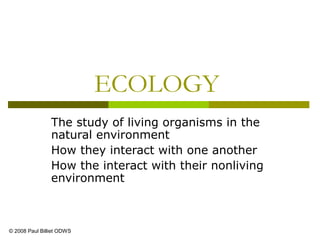More Related Content
Similar to 01 ecology 2 (20)
01 ecology 2
- 1. ECOLOGY
The study of living organisms in the
natural environment
How they interact with one another
How the interact with their nonliving
environment
© 2008 Paul Billiet ODWS
- 3. Community
All the populations of the different species living and
inter-acting in the same ecosystem
7-spotted lady
bird
(Adephagia
septempunctata)
Bean aphids
(Aphis fabae)
Red ant
(Myrmica rubra)
and
Broom plant
(Cytisus
scoparius)
© 2008 Paul Billiet ODWS
- 4. Species
A group of organisms that can breed to
produce fully fertile offspring
Great White Pelican Pelecanus onocrotalus© 2008 Paul Billiet ODWS
- 5. Population
A group of organism of
the same species which
live in the same habitat
at the same time where
they can freely
interbreed
The black-veined white butterfly
(Aporia crataegi) mating
© 2008 Paul Billiet ODWS
- 6. Biodiversity
The total number of
different species in an
ecosystem and their
relative abundance
Worcester City Museums© 2008 Paul Billiet ODWS
- 7. Habitat
The characteristics of the type of environment
where an organism normally lives.
(e.g. a stoney stream, a deciduous temperate
woodland, Bavarian beer mats)
© 2008 Paul Billiet ODWS
- 8. Energy and organisms
Autotrophs
Organisms which can synthesise their own
complex, energy rich, organic molecules from
simple inorganic molecules (e.g. green plants
synthesis sugars from CO2 and H2O)
© 2008 Paul Billiet ODWS
- 9. Heterotrophs
Organisms who must obtain complex,
energy rich, organic compounds form the
bodies of other organisms (dead or alive)
© 2008 Paul Billiet ODWS
- 11. Saprotrophs
Heterotrophic organisms who secrete digestive
enzymes onto dead organism matter and absorb
the digested material. (e.g. fungi, bacteria)
Chanterelle
(Cantherellus
cibarius)
© 2008 Paul Billiet ODWS
- 13. The place of an organism in its
environment
Niche
An organism’s habitat + role + tolerance
limits to all limiting factors
© 2008 Paul Billiet ODWS
- 14. THE COMPETITIVE
EXCLUSION PRINCIPLE
G.F. Gause (1934)
If two species, with the same niche, coexist
in the same ecosystem, then one will be
excluded from the community due to intense
competition
© 2008 Paul Billiet ODWS
- 15. Niche
The niche of a species consists of:
Its role in the ecosystem (herbivore,
carnivore, producer etc)
Its tolerance limits (e.g. soil pH, humidity)
Its requirements for shelter, nesting sites
etc etc, all varying through time
© 2008 Paul Billiet ODWS
- 16. The niche as a two-dimensional shape
Niche represented
by a 2-dimensional
area
Species A
© 2008 Paul Billiet ODWS
- 19. Species C
Specialisation avoids competition
Evolution by
natural selection
towards
separate niches
Species B’ Species C’
Specialisation into two separate niches
Species B
© 2008 Paul Billiet ODWS
- 20. This niche is not big enough for the
both of us!
Species A Species D
Very heavy competition leads to
competitive exclusion
One species must go
© 2008 Paul Billiet ODWS
- 21. Total exclusion
Species A has a
bigger niche it is
more generalist
Species E has a smaller
niche it is more specialist
Specialists, however, do
tend to avoid competition
Here it is total swamped
by Species A
© 2008 Paul Billiet ODWS
- 22. Example: Squirrels in Britain
The Red Squirrel
(Sciurus vulgaris) is
native to Britain
Its population has
declined due to:
Competitive exclusion
Disease
Disappearance of hazel
coppices and mature
conifer forests in
lowland Britain
Isle of Wight Tourist Guide
© 2008 Paul Billiet ODWS
- 23. The Alien
The Grey Squirrel
(Sciurus carolinensis)
is an alien species
Introduced to Britain in
about 30 sites between
1876 and 1929
It has easily adapted to
parks and gardens
replacing the red
squirrel
Bananas in the Falklands
© 2008 Paul Billiet ODWS
